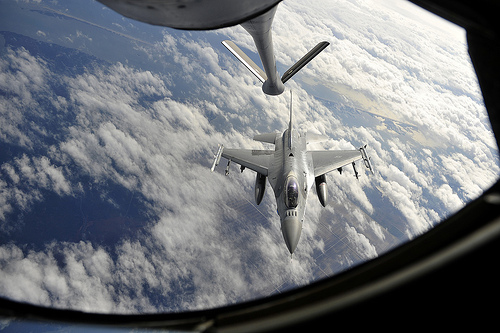I like to run. One thing runners know, really that all athletes amateur to professional know, is that when you take time off or scale back on your training because of an injury or the like, it takes time to recover. I don’t mean taking a day off to recover here and there. I mean taking say a month off.
Sure, you can start running again – but you won’t be at the same level as when you took the break for quite some time. And, to make it even better, it’s often a bit painful getting back up to that level.
Why do I bring this up? Because the same holds true for military capabilities.
Air Combat Command recently stood down one-third of its combat squadrons. This was done because aircraft are expensive to maintain and operate and because sequestration means a lack of funds. By standing down some units, others will be able to maintain their full operational capabilities. Specific units have yet to identified, but the main point is that America is putting one-third of its combat airpower on hold.
Some may ask what this really means. Pilots take breaks all the time. Surely this won’t hurt, right? Heck, it might even be a bit of a vacation for the affected Airmen.
So, will this diminish America’s combat airpower?
Today? No.
Tomorrow? No.
Next week? Next month? The answer there is probably and then definitely.
It generally takes about 60-90 days to return a unit to full operational status post-deployment. More importantly, after roughly 30 days of inactivity, many of the core functions associated with flying – from maintenance to dropping ordnance, are no longer current.
Yes, some of those skills can be practiced virtually in simulators and the like. However, for certain key skills, nothing substitutes for the real, live version.
This is where my running analogy comes into play. By standing down units for an as yet to be determined, but extended time, American airpower will lose its edge. Even if the units are brought back up to full-speed next month, they’re going to have to train harder and more often to get back to where they were when told to stop flying.
First, we cannot afford to lose our airpower edge. We have operated in environments where we’ve controlled the air since the 1950s. Our ground forces rely on airpower in all forms – strike, ISR, close air support, mobility and more – to accomplish their mission. Without airpower, our forces are at a disadvantage, plain and simple.
Second, these aircraft are not flying because of fiscal reasons. Getting them back up operationally will eventually cost more, both in dollars and in risk. Yes, it may seem like this is saving money, but that reduced amount of money is not being saved, it is being concentrated on the units still flying. Meanwhile, once these units start flying again, it will take them that much longer to bring their skills back up to speed.
The decision to stop flying these aircraft because of money is understandable. Money is tight and rather than have a mid-level, partially funded force across the board, America is accepting a smaller, higher-level force. However, this compromise carries risk.
Meanwhile, what about the Airmen if those squadrons that aren’t flying? How do they stay productive? What can the Air Force do to keep their skills up?
Some might suggest a relay team approach – shuttling maintenance and aircrew between flying and non-flying units. Besides the logistics involved, there’s the cost. Travel is not cheap.
What about simulators. Those are always a good option – but as noted above, simulators can only take an Airman so far.
No, by temporarily alleviating the fiscal issue, a new one related to personnel is created.
Left with no choice, the Air Force has done the only thing it could do in order to remain capable of presenting at least some combat force. However, there has got to be a better way. America cannot afford to lose its airpower capabilities and put its people and its security at risk.
Lieutenant Colonel Aaron Burgstein is the Air Force fellow at the Atlantic Council’s Brent Scowcroft Center on International Security. The conclusions and opinions expressed in this document are those of the author. They do not reflect the official position of the US government, Department of Defense, or the United States Air Force.
Image: 8498079556_ee6df78b7a.jpg
